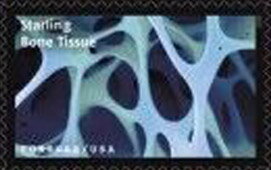Stamp: Starling Bone Tissue (United States of America 2023)
Starling Bone Tissue (United States of America 2023)
10 August (United States of America ) within release Life Magnified (2023) goes into circulation Stamp Starling Bone Tissue face value FOREVER No Face Value
| Stamp Starling Bone Tissue in catalogues | |
|---|---|
| Colnect codes: | Col: US 2023.08.10-01k |
Stamp is horizontal format.
Stamp from mini-sheet. Face value US$0.66 on day of issueAlso in the issue Life Magnified (2023):
- Stamp - Acorn Barnacle face value FOREVER;
- Stamp - Arranged Diatoms face value FOREVER;
- Stamp - Barnacle Legs face value FOREVER;
- Stamp - Blue Button Organism face value FOREVER;
- Stamp - Diving Beetle Front Foot face value FOREVER;
- Stamp - Flame Lily Pollen face value FOREVER;
- Stamp - Freshwater Protozoans face value FOREVER;
- Stamp - Freshwater Snail Tongue face value FOREVER;
- Stamp - Human Hair face value FOREVER;
- Mini Sheet - Life Magnified face value 20*FOREVER;
- Stamp - Macaw Parrot Feathers face value FOREVER;
- Stamp - Mold Spores face value FOREVER;
- Stamp - Moss Leaves face value FOREVER;
- Stamp - Moth Antenna face value FOREVER;
- Stamp - Moth Wing Scales face value FOREVER;
- Stamp - Mouse Brain Neurons face value FOREVER;
- Stamp - Mushroom Gills face value FOREVER;
- Stamp - Oak Leaf Surface face value FOREVER;
- Stamp - Red Blood Cells face value FOREVER;
- Stamp - Starling Bone Tissue face value FOREVER;
- Stamp - Zebrafish face value FOREVER;
- Full Pane - Life Magnified Imperf face value None;
Stamp Starling Bone Tissue it reflects the thematic directions:
Animals are multicellular, eukaryotic organisms of the kingdom Animalia (also called Metazoa). All animals are motile, meaning they can move spontaneously and independently, at some point in their lives. Their body plan eventually becomes fixed as they develop, although some undergo a process of metamorphosis later on in their lives. All animals are heterotrophs: they must ingest other organisms or their products for sustenance.
Birds (Aves), a subgroup of Reptiles, are the last living examples of Dinosaurs. They are a group of endothermic vertebrates, characterised by feathers, toothless beaked jaws, the laying of hard-shelled eggs, a high metabolic rate, a four-chambered heart, and a strong yet lightweight skeleton. Birds live worldwide and range in size from the 5 cm (2 in) bee hummingbird to the 2.75 m (9 ft) ostrich. They rank as the class of tetrapods with the most living species, at approximately ten thousand, with more than half of these being passerines, sometimes known as perching birds. Birds are the closest living relatives of crocodilians.
Science is a systematic discipline that builds and organises knowledge in the form of testable hypotheses and predictions about the universe.Modern science is typically divided into two or three major branches: the natural sciences (e.g., physics, chemistry, and biology), which study the physical world; and the behavioural sciences (e.g., economics, psychology, and sociology), which study individuals and societies.The formal sciences (e.g., logic, mathematics, and theoretical computer science), which study formal systems governed by axioms and rules, are sometimes described as being sciences as well; however, they are often regarded as a separate field because they rely on deductive reasoning instead of the scientific method or empirical evidence as their main methodology. Applied sciences are disciplines that use scientific knowledge for practical purposes, such as engineering and medicine



